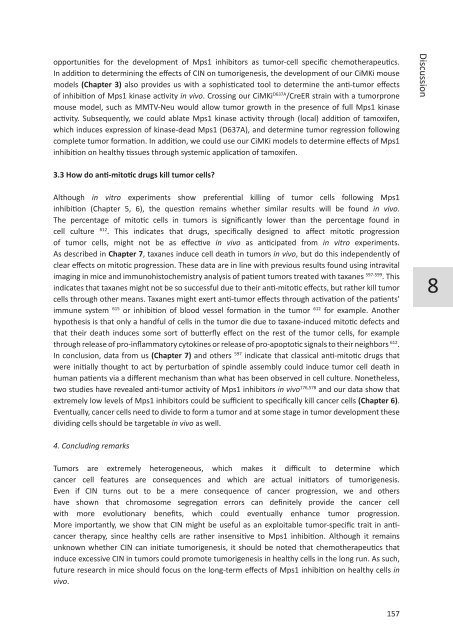Chromosome segregation errors: a double-edged sword - TI Pharma
Chromosome segregation errors: a double-edged sword - TI Pharma
Chromosome segregation errors: a double-edged sword - TI Pharma
Create successful ePaper yourself
Turn your PDF publications into a flip-book with our unique Google optimized e-Paper software.
opportunities for the development of Mps1 inhibitors as tumor-cell specific chemotherapeutics.<br />
In addition to determining the effects of CIN on tumorigenesis, the development of our CiMKi mouse<br />
models (Chapter 3) also provides us with a sophisticated tool to determine the anti-tumor effects<br />
of inhibition of Mps1 kinase activity in vivo. Crossing our CiMKi D637A /CreER strain with a tumorprone<br />
mouse model, such as MMTV-Neu would allow tumor growth in the presence of full Mps1 kinase<br />
activity. Subsequently, we could ablate Mps1 kinase activity through (local) addition of tamoxifen,<br />
which induces expression of kinase-dead Mps1 (D637A), and determine tumor regression following<br />
complete tumor formation. In addition, we could use our CiMKi models to determine effects of Mps1<br />
inhibition on healthy tissues through systemic application of tamoxifen.<br />
3.3 How do anti-mitotic drugs kill tumor cells?<br />
Although in vitro experiments show preferential killing of tumor cells following Mps1<br />
inhibition (Chapter 5, 6), the question remains whether similar results will be found in vivo.<br />
The percentage of mitotic cells in tumors is significantly lower than the percentage found in<br />
cell culture 612 . This indicates that drugs, specifically designed to affect mitotic progression<br />
of tumor cells, might not be as effective in vivo as anticipated from in vitro experiments.<br />
As described in Chapter 7, taxanes induce cell death in tumors in vivo, but do this independently of<br />
clear effects on mitotic progression. These data are in line with previous results found using intravital<br />
imaging in mice and immunohistochemistry analysis of patient tumors treated with taxanes 597-599 . This<br />
indicates that taxanes might not be so successful due to their anti-mitotic effects, but rather kill tumor<br />
cells through other means. Taxanes might exert anti-tumor effects through activation of the patients’<br />
immune system 615 or inhibition of blood vessel formation in the tumor 612 for example. Another<br />
hypothesis is that only a handful of cells in the tumor die due to taxane-induced mitotic defects and<br />
that their death induces some sort of butterfly effect on the rest of the tumor cells, for example<br />
through release of pro-inflammatory cytokines or release of pro-apoptotic signals to their neighbors 612 .<br />
In conclusion, data from us (Chapter 7) and others 597 indicate that classical anti-mitotic drugs that<br />
were initially thought to act by perturbation of spindle assembly could induce tumor cell death in<br />
human patients via a different mechanism than what has been observed in cell culture. Nonetheless,<br />
two studies have revealed anti-tumor activity of Mps1 inhibitors in vivo 176,578 and our data show that<br />
extremely low levels of Mps1 inhibitors could be sufficient to specifically kill cancer cells (Chapter 6).<br />
Eventually, cancer cells need to divide to form a tumor and at some stage in tumor development these<br />
dividing cells should be targetable in vivo as well.<br />
4. Concluding remarks<br />
Tumors are extremely heterogeneous, which makes it difficult to determine which<br />
cancer cell features are consequences and which are actual initiators of tumorigenesis.<br />
Even if CIN turns out to be a mere consequence of cancer progression, we and others<br />
have shown that chromosome <strong>segregation</strong> <strong>errors</strong> can definitely provide the cancer cell<br />
with more evolutionary benefits, which could eventually enhance tumor progression.<br />
More importantly, we show that CIN might be useful as an exploitable tumor-specific trait in anticancer<br />
therapy, since healthy cells are rather insensitive to Mps1 inhibition. Although it remains<br />
unknown whether CIN can initiate tumorigenesis, it should be noted that chemotherapeutics that<br />
induce excessive CIN in tumors could promote tumorigenesis in healthy cells in the long run. As such,<br />
future research in mice should focus on the long-term effects of Mps1 inhibition on healthy cells in<br />
vivo.<br />
157<br />
Discussion<br />
8













